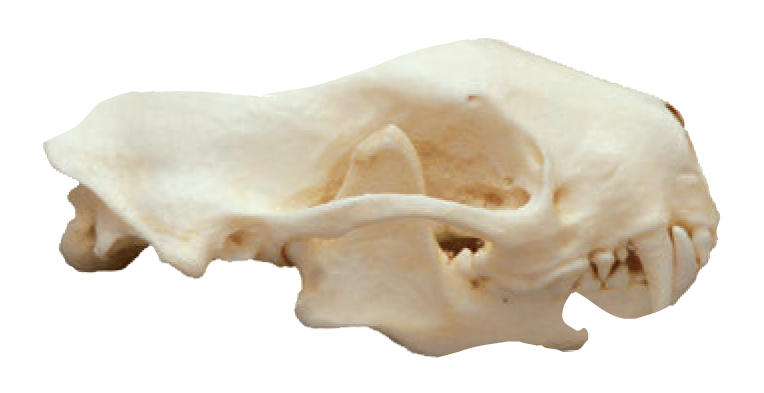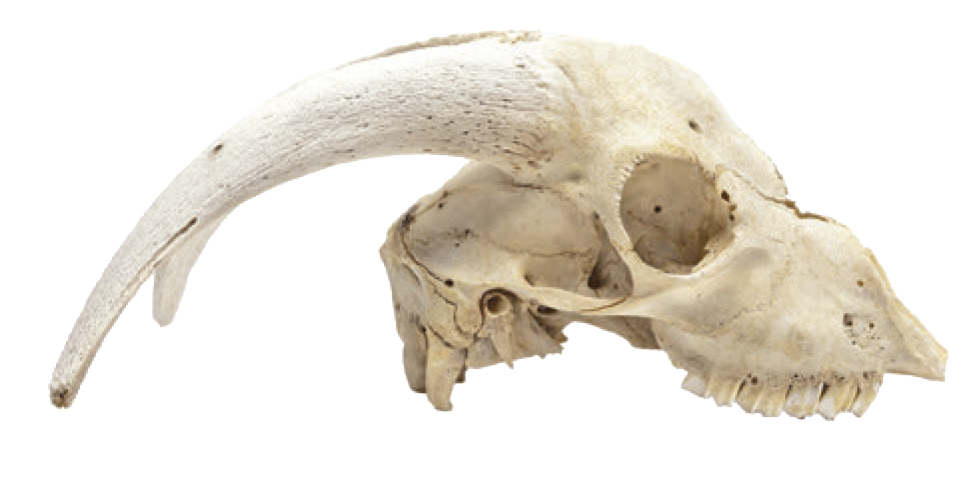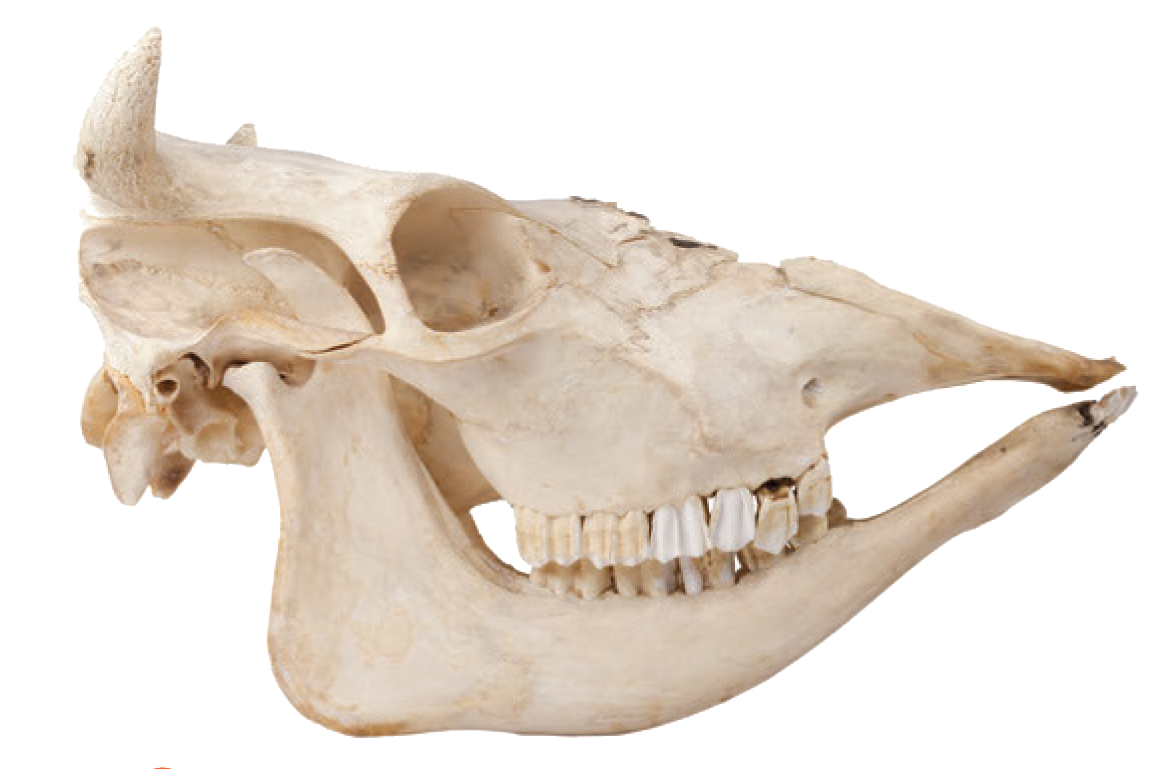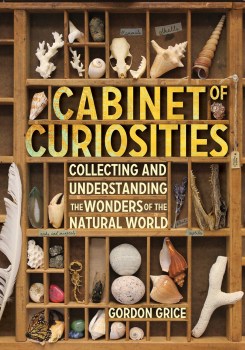Know Your Common Mammal Skulls
An excerpt from “Cabinet of Curiosities.”
The following is an excerpt from Cabinet of Curiosities, by Gordon Grice.
A skull is the bony bowl that protects an animal’s brain. Not all animals have skulls. For example, insects and octopuses don’t have any bones at all. But mammals do—and their skulls and teeth can be pretty easy to find for a budding collector.
In most mammals, the upper teeth are attached to the skull. The bottom teeth are attached to the lower jaw. The lower jaw is not part of the skull. When the animal is alive, the lower jaw is attached to the skull by soft tissues. After an animal dies, those soft tissues decay. So if you find a skull in the wild, you may not find the lower jaw with it. Both pieces—the lower jaw and the skull—are fun to collect. Often, the teeth will remain planted in the skull or lower jaw, which can help you figure out what kind of a skull you have. Each mammal has a certain number of each kind of tooth. Scientists call this information a “dental formula.” It is the first thing they look at when they want to identify a skull.

Skunk (genus Mephitis)
There are twelve different species of skunks. Skunks eat a wide variety of foods including insects, worms, plants, garbage, and pet food people leave out for their cats and dogs. That last habit often brings them into conflict with humans. The skunk usually wins. Unlike many wild animals, skunks don’t readily run away when confronted by a human. Their ability to spray a horrible smelling fluid makes them bold. They keep eating what they want and only waddle away when they’re done.
Like most carnivoras, they also eat meat. They obtain the meat by preying on small animals like lizards, frogs, and mice, and also by scavenging—eating animals that are already dead. Their skulls match their meat-eating ways. The dental formula of one common species, the striped skunk (Mephitis mephitis), is . The skull is small enough to hold in your palm, and the ridge of carnassial teeth will be clearly visible on the sides. Other teeth often fall out after death, but in a good specimen you’ll still be able to see the holes they were in.

Goat (genus Capra)
The goat has been closely associated with humans for at least ten thousand years, and it’s become one of the most useful animals. Its milk is suitable for drinking. (It tastes stronger and less sweet than cow’s milk.) Its meat is a staple in some parts of the world. Its hide can be made into clothes. Even the hair of some breeds can be spun into wool.
Goat skulls are a common item for a collection because they are fairly easy to find. Goats can be found in the wild or on farms. Many of them have two long, curved horns protruding from the top of their skulls. The dental formula is . If you find the skull without the lower jaw, there will be no teeth at all in front, only the flattened premolars and molars in back. That’s because a goat mostly eats plants.
Squirrel (genus Sciurus)
Squirrel skulls are small enough to fit in the palm of your hand. Squirrels, like other rodents, have unusual teeth. At the very front of a squirrel’s head are a few very long, sharp incisors. The squirrel’s incisors can bite off a chunk of food, like ours do, but they are also good at gnawing on things, like the hard shells of nuts. The squirrel wears its incisors down gnawing through hard things, but they grow fast to keep up with the wear. (Rats, which are also rodents, can even gnaw through concrete and steel.)
Rodents—including squirrels, rats, mice, gerbils, guinea pigs, beavers, and others—lack canine teeth. Where their canine teeth would be, there’s an empty space. The rodent uses this empty space for holding on to things it wants to gnaw—like acorns. With an acorn held tight in that empty jaw space, a squirrel can really get to work with its incisors. In the case of one common species called the Eastern gray squirrel (Sciurus carolinensis ), the empty space is big enough for a walnut. The squirrel’s molars—typically three on each side of the top jaw—are tiny compared to a person’s.
Another prominent feature of a squirrel skull is the big eye holes, or eye sockets. For a small animal, a squirrel has enormous eyes. It uses them to look around for predators. Squirrels need excellent vision to help them judge leaps between branches.


Cow (genus Bos)
At first glance, a cow’s skull doesn’t look like it came from a cow. It lacks the broad, velvety nose and the twitchy ears. These parts are made of soft tissue rather than bone, so they don’t last. There’s nothing left of its ears to let you know what powerful instruments they were. A cow can hear sounds too deep and too high for human ears.
The nose is another matter. Even though the fleshy end is gone, the skull will still reveal the long snout. The large size of the snout is a hint that the cow also had a good sense of smell. Cattle can sometimes detect predators miles away just by scent.
Then there are the eyes. Their sockets are placed on the sides of the head so that the cow can see in almost every direction at once. This is a useful trait for a prey species that must constantly watch for predators.
*This article was updated on February 3, 2017. A photo of what was identified as a squirrel was removed. The photo actually featured a rabbit.
Excerpt from Cabinets of Curiosities © Workman Publishing.
Gordon Grice is a nature writer and author of Cabinet of Curiosities.